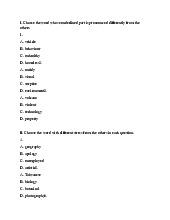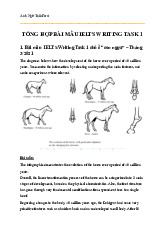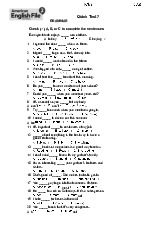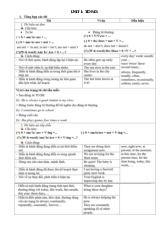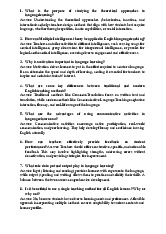
















Preview text:
lOMoAR cPSD| 59540283
IELTS Practice Tests Plus Volume 1
Reading Practice Test 1 HOW TO USE
You have 2 ways to access the test
1. Open this URL https://link.intergreat.com/ROOUp on your computer
2. Use your mobile device to scan the QR code attached Reading Passage 1
You should spend about 20 minutes on Questions 1-13. which are based on Reading Passage 1 below. lOMoAR cPSD| 59540283 In Praise of Amateurs
Despite the specialization of scientific research, amateurs still have an important role to play.
During the scientific revolution of the 17th century, scientists were largely men of private means who
pursued their interest in natural philosophy for their own edification. Only in the past century or two has
it become possible to make a living from investigating the workings of nature. Modern science was, in
other words, built on the work of amateurs. Today, science is an increasingly specialized and
compartmentalized subject, the domain of experts who know more and more about less and less. Perhaps
surprisingly, however, amateurs – even those without private means – are still important.
A recent poll carried out at a meeting of the American Association for the Advancement of Science by
astronomer Dr Richard Fienberg found that, in addition to his field of astronomy, amateurs are actively
involved in such fields as acoustics, horticulture, ornithology, meteorology, hydrology and palaeontology.
Far from being crackpots, amateur scientists are often in close touch with professionals, some of whom
rely heavily on their co-operation.
Admittedly, some fields are more open to amateurs than others. Anything that requires expensive
equipment is clearly a no-go area. And some kinds of research can be dangerous; most amateur chemists,
jokes Dr Fienberg, are either locked up or have blown themselves to bits. But amateurs can make valuable
contributions in fields from rocketry to palaeontology and the rise of the Internet has made it easier than
before to collect data and distribute results.
Exactly which field of study has benefited most from the contributions of amateurs is a matter of some
dispute. Dr Fienberg makes a strong case for astronomy. There is, he points out, a long tradition of
collaboration between amateur and professional sky watchers. Numerous comets, asteroids and even the
planet Uranus were discovered by amateurs. Today, in addition to comet and asteroid spotting, amateurs
continue to do valuable work observing the brightness of variable stars and detecting novae- ‘new’ stars
in the Milky Way and supernovae in other galaxies. Amateur observers are helpful, says Dr Fienberg, lOMoAR cPSD| 59540283
because there are so many of them (they far outnumber professionals) and because they are distributed
all over the world. This makes special kinds of observations possible:’ if several observers around the
world accurately record the time when a star is eclipsed by an asteroid, for example, it is possible to derive
useful information about the asteroid’s shape.
Another field in which amateurs have traditionally played an important role is palaeontology. Adrian Hunt,
a palaeontologist at Mesa Technical College in New Mexico, insists that his is the field in which amateurs
have made the biggest contribution. Despite the development of hightech equipment, he says, the best
sensors for finding fossils are human eyes – lots of them.
Finding volunteers to look for fossils is not difficult, he says, because of the near universal interest in
anything to do with dinosaurs. As well as helping with this research, volunteers learn about science, a
process he calls ‘recreational education’.
Rick Bonney of the Cornell Laboratory of Ornithology in Ithaca, New York, contends that amateurs have
contributed the most in his field. There are, he notes, thought to be as many as 60 million birdwatchers
in America alone. Given their huge numbers and the wide geographical coverage they provide, Mr Bonney
has enlisted thousands of amateurs in a number of research projects. Over the past few years their
observations have uncovered previously unknown trends and cycles in bird migrations and revealed
declines in the breeding populations of several species of migratory birds, prompting a habitat conservation programme.
Despite the successes and whatever the field of study, collaboration between amateurs and professionals
is not without its difficulties. Not everyone, for example is happy with the term ‘amateur’. Mr Bonney has
coined the term ‘citizen scientist’ because he felt that other words, such as ‘volunteer’ sounded
disparaging. A more serious problem is the question of how professionals can best acknowledge the
contributions made by amateurs. Dr Fienberg says that some amateur astronomers are happy to provide
their observations but grumble about not being reimbursed for out-of-pocket expenses. Others feel let
down when their observations are used in scientific papers, but they are not listed as co-authors. Dr Hunt
says some amateur palaeontologists are disappointed when told that they cannot take finds home with them.
These are legitimate concerns but none seems insurmountable. Provided amateurs and professionals
agree the terms on which they will work together beforehand, there is no reason why co-operation
between the two groups should not flourish. Last year Dr S. Carlson, founder of the Society for Amateur
Scientists won an award worth $290,000 for his work in promoting such co-operation. He says that one of
the main benefits of the prize is the endorsement it has given to the contributions of amateur scientists,
which has done much to silence critics among those professionals who believe science should remain their exclusive preserve.
At the moment, says Dr Carlson, the society is involved in several schemes including an innovative rocket-
design project and the setting up of a network of observers who will search for evidence of a link between
low- frequency radiation and earthquakes. The amateurs, he says, provide enthusiasm and talent, while lOMoAR cPSD| 59540283
the professionals provide guidance ‘so that anything they do discover will be taken seriously’. Having laid
the foundations of science, amateurs will have much to contribute to its ever – expanding edifice.
------------------------------- Small Tip
Read through the summary at normal speed so that you have a fair idea of what it is about. Check the
instructions: you can use a maximum of two words for each answer and these words must be taken from
the reading passage. If you use more than two words or words that are not in the passage, the answer will be marked wrong.
Skim the passage and find out where the part that has been summarised begins. Read the text
around each gap carefully. See if you can predict the answer or the kind of word(s) that you are looking for.
Select the best word from the text for each gap.
Re-read the summary, with the words you have selected for each gap, to make sure that it makes sense
both grammatically and in terms of meaning. Questions 1-8
Complete the summary below. Choose ONE or TWO WORDS from the passage for each answer.
Write your answers in boxes 1-8 on your answer sheet. Summary
Prior to the 19th century, professional 1
did not exist and scientific research
was largely carried out by amateurs. However, while 2 today is mostly the
domain of professionals, a recent US survey highlighted the fact that amateurs play an
important role in at least seven 3
and indeed many professionals are reliant on their 4
. In areas such as astronomy, amateurs can be invaluable when making specific 5 on a global basis.
Similarly in the area of palaeontology their involvement is invaluable and helpers are easy
to recruit because of the popularity of 6
. Amateur birdwatchers also play an
active role and their work has led to the establishment of a 7
. Occasionally the term 'amateur' has been the source of disagreement
and alternative names have been suggested but generally speaking, as long as the professional scientists 8
the work of the nonprofessionals, the two groups
can work productively together. lOMoAR cPSD| 59540283 Questions 9-13
Reading Passage 1 contains a number of opinions provided by four different scientists. Match
each opinion (Questions 9-13) with the scientists A-D.
NB You may use any of the scientists A-D more than once. Name of scientists A Dr Fienberg B Adrian Hunt C Rick Bonney D Dr Carlson
Amateur scientists are prone to accidents.
Science does not belong to professional scientists alone.
In certain areas of my work, people are a more valuable resource than technology. 13
It is important to give amateurs a name which reflects the value of their work. lOMoAR cPSD| 59540283 lOMoAR cPSD| 59540283 Reading Passage 2
You should spend about 20 minutes on Questions 14-26, which are based on Reading Passage 2 below: READING THE SCREEN
Are the electronic media exacerbating illiteracy and making our children stupid? On the contrary, says
Colin McCabe, they have the potential to make us truly literate.
The debate surrounding literacy is one of the most charged in education. On the one hand there is an
army of people convinced that traditional skills of reading and writing are declining. On the other, a host
of progressives protest that literacy is much more complicated than a simple technical mastery of reading
and writing. This second position is supported by most of the relevant academic work over the past 20
years. These studies argue that literacy can only be understood in its social and technical context. In
Renaissance England, for example, many more people could read than could write, and within reading
there was a distinction between those who could read print and those who could manage the more
difficult task of reading manuscript. An understanding of these earlier periods helps us understand today’s
‘crisis in literacy’ debate.
There does seem to be evidence that there has been an overall decline in some aspects of reading and
writing - you only need to compare the tabloid newspapers of today with those of 50 years ago to see a
clear decrease in vocabulary and simplification of syntax. But the picture is not uniform and doesn’t readily
demonstrate the simple distinction between literate and illiterate which had been considered adequate
since the middle of the 19th century.
While reading a certain amount of writing is as crucial as it has ever been in industrial societies, it is
doubtful whether a fully extended grasp of either is as necessary as it was 30 or 40 years ago. While print
retains much of its authority as a source of topical information, television has increasingly usurped this
role. The ability to write fluent letters has been undermined by the telephone and research suggests that
for many people the only use for writing, outside formal education, is the compilation of shopping lists. lOMoAR cPSD| 59540283
The decision of some car manufacturers to issue their instructions to mechanics as a video pack rather
than as a handbook might be taken to spell the end of any automatic link between industrialisation and
literacy. On the other hand, it is also the case that ever-increasing numbers of people make their living
out of writing, which is better rewarded than ever before. Schools are generally seen as institutions where
the book rules - film, television and recorded sound have almost no place; but it is not clear that this
opposition is appropriate. While you may not need to read and write to watch television, you certainly
need to be able to read and write in order to make programmes.
Those who work in the new media are anything but illiterate. The traditional oppositions between old and
new media are inadequate for understanding the world which a young child now encounters. The
computer has re-established a central place for the written word on the screen, which used to be entirely
devoted to the image. There is even anecdotal evidence that children are mastering reading and writing
in order to get on to the Internet. There is no reason why the new and old media cannot be integrated in
schools to provide the skills to become economically productive and politically enfranchised.
Nevertheless, there is a crisis in literacy and it would be foolish to ignore it. To understand that literacy
may be declining because it is less central to some aspects of everyday life is not the same as acquiescing
in this state of affairs. The production of school work with the new technologies could be a significant
stimulus to literacy. How should these new technologies be introduced into the schools? It isn’t enough
to call for computers, camcorders and edit suites in every classroom; unless they are properly integrated
into the educational culture, they will stand unused. Evidence suggests that this is the fate of most
information technology used in the classroom. Similarly, although media studies are now part of the
national curriculum, and more and more students are now clamouring to take these course, teachers
remain uncertain about both methods and aims in this area.
This is not the fault of the teachers. The entertainment and information industries must be drawn into a
debate with the educational institutions to determine how best to blend these new technologies into the classroom.
Many people in our era are drawn to the pessimistic view that the new media are destroying old skills and
eroding critical judgement. It may be true that past generations were more literate but - taking the pre-
19th century meaning of the term - this was true of only a small section of the population. The word
literacy is a 19th-century coinage to describe the divorce of reading and writing from a full knowledge of
literature. The education reforms of the 19th century produced reading and writing as skills separable
from full participation in the cultural heritage.
The new media now point not only to a futuristic cyber-economy, they also make our cultural past
available to the whole nation. Most children’s access to these treasures is initially through television. It is
doubtful whether our literary heritage has ever been available to or sought out by more than about 5 per
cent of the population; it has certainly not been available to more than 10 per cent. But the new media
joined to the old, through the public service tradition of British broadcasting, now makes our literary tradition available to all. lOMoAR cPSD| 59540283 Questions 14-17
Choose the appropriate letters A-D and write them in boxes 14-17 on your answer sheet.
14 When discussing the debate on literacy in education, the writer notes that
children cannot read and write as well as they used to. academic
work has improved over the last 20 years. there is evidence that
literacy is related to external factors.
there are opposing arguments that are equally convincing.
15 In the 4th paragraph, the writer’s main point is that
the printed word is both gaining and losing power. all
inventions bring disadvantages as well as benefits. those who
work in manual jobs no longer need to read.
the media offers the best careers for those who like writing.
16 According to the writer, the main problem that schools face today is
how best to teach the skills of reading and writing.
how best to incorporate technology into classroom teaching.
finding the means to purchase technological equipment.
managing the widely differing levels of literacy amongst pupils.
17 At the end of the article, the writer is suggesting that lOMoAR cPSD| 59540283
literature and culture cannot be divorced. the term ‘literacy’
has not been very useful. 10 per cent of the population never
read literature. our exposure to cultural information is likely to increase. Questions 18-23
Do the following statements agree with the views of the writer in Reading Passage 2?
In boxes 18-23 on your answer sheet write YES
if the statement agrees with the views of the writer NO
if the statement contradicts the views of the writer NOT GIVEN
if it is impossible to say what the writer thinks about this
It is not as easy to analyse literacy levels as it used to be.
Our literacy skills need to be as highly developed as they were in the past.
Illiteracy is on the increase.
Professional writers earn relatively more than they used to.
A good literacy level is important for those who work in television. 23
Computers are having a negative impact on literacy in schools lOMoAR cPSD| 59540283 Questions 24-26
Complete the sentences below with words taken from Reading Passage 2.
Write your answers in boxes 24-26 on your answer sheet.
Use NO MORE THAN THREE WORDS for each answer. Reading Passage 3
You should spend about 20 minutes on Questions 27-40, which are based on Reading Passage 3 below. lOMoAR cPSD| 59540283
The Revolutionary Bridges of Robert Maillart
Swiss engineer Robert Maillart built some of the greatest bridges of the 20th century. His designs elegantly
solved a basic engineering problem: how to support enormous weights using a slender arch. A
Just as railway bridges were the great structural symbols of the 19th century, highwaybridges
became the engineering emblems of the 20th century. The invention of the automobile created an
irresistible demand for paved roads and vehicular bridges throughout the developed world. The type of
bridge needed for cars and trucks, however, is fundamentally different from that needed for locomotives.
Most highway bridges carry lighter loads than railway bridges do, and their roadways can be sharply
curved or steeply sloping. To meet these needs, many turnof-the-century bridge designers began working
with a new building material: reinforced concrete, which has steel bars embedded in it. And the master
of this new material was Swiss structural engineer, Robert Maillart. B
Early in his career, Maillart developed a unique method for designing bridges, buildings andother
concrete structures. He rejected the complex mathematical analysis of loads and stresses that was being
enthusiastically adopted by most of his contemporaries. At the same time, he also eschewed the
decorative approach taken by many bridge builders of his time. He resisted imitating architectural styles
and adding design elements solely for ornamentation. Maillart’s method was a form of creative intuition.
He had a knack for conceiving new shapes to solve classic engineering problems] And because he worked
in a highly competitive field, one of his goals was economy - he won design and construction contracts
because his structures were reasonably priced, often less costly than all his rivals’ proposals. C
Maillart’s first important bridge was built in the small Swiss town of Zuoz. The local officialshad
initially wanted a steel bridge to span the 30-metre wide Inn River, but Maillart argued that he could build
a more elegant bridge made of reinforced concrete for about the same cost. His crucial innovation was
incorporating the bridge’s arch and roadway into a form called the hollow-box arch, which would lOMoAR cPSD| 59540283
substantially reduce the bridge’s expense by minimising the amount of concrete needed. In a conventional
arch bridge the weight of the roadway is transferred by columns to the arch, which must be relatively
thick. In Maillart’s design, though, the roadway and arch were connected by three vertical walls, forming
two hollow boxes running under the roadway (see diagram). The big advantage of this design was that
because the arch would not have to bear the load alone, it could be much thinner - as little as one-third
as thick as the arch in the conventional bridge. D
His first masterpiece, however, was the 1905 Tavanasa Bridge over the Rhine river in theSwiss Alps.
In this design, Maillart removed the parts of the vertical walls which were not essential because they
carried no load. This produced a slender, lighter-looking form, which perfectly met the bridge’s structural
requirements. But the Tavanasa Bridge gained little favourable publicity in Switzerland; on the contrary, it
aroused strong aesthetic objections from public officials who were more comfortable with old-fashioned
stone-faced bridges. Maillart, who had founded his own construction firm in 1902, was unable to win any
more bridge projects, so he shifted his focus to designing buildings, water tanks and other structures made
of reinforced concrete and did not resume his work on concrete bridges until the early 1920s. E
His most important breakthrough during this period was the development of the deck-stiffened
arch, the first example of which was the Flienglibach Bridge, built in 1923. An arch bridge is somewhat
like an inverted cable. A cable curves downward when a weight is hung from it, an arch bridge curves
upward to support the roadway and the compression in the arch balances the dead load of the traffic. For
aesthetic reasons, Maillart wanted a thinner arch and his solution was to connect the arch to the roadway
with transverse walls. In this way, Maillart justified making the arch as thin as he could reasonably build
it. His analysis accurately predicted the behaviour of the bridge but the leading authorities of Swiss
engineering would argue against his methods for the next quarter of a century. F
Over the next 10 years, Maillart concentrated on refining the visual appearance of the deck-
stiffened arch. His best-known structure is the Salginatobel Bridge, completed in 1930. He won the
competition for the contract because his design was the least expensive of the 19 submitted - the bridge
and road were built for only 700,000 Swiss francs, equivalent to some $3.5 million today. Salginatobel was
also Maillart’s longest span, at 90 metres and it had the most dramatic setting of all his structures, vaulting
80 metres above the ravine of the Salgina brook. In 1991 it became the first concrete bridge to be
designated an international historic landmark. G
Before his death in 1940, Maillart completed other remarkable bridges and continued torefine his
designs. However, architects often recognised the high quality of Maillart’s structures before his fellow
engineers did and in 1947 the architectural section of the Museum of Modern Art in New York City
devoted a major exhibition entirely to his works. In contrast, very few American structural engineers at
that time had even heard of Maillart. In the following years, however, engineers realised that Maillart’s
bridges were more than just aesthetically pleasing they were technically unsurpassed. Maillart’s hollow-
box arch became the dominant design form for medium and long- span concrete bridges in the US. In
Switzerland, professors finally began to teach Maillart’s ideas, which then influenced a new generation of designers. lOMoAR cPSD| 59540283 Questions 27-33
Reading Passage 3 has seven paragraphs A-G.
From the list of headings below choose the most suitable heading for each paragraph.
Write the appropriate numbers (i—x) in boxes 27-33 on your answer sheet. List of headings i The long-term impact ii A celebrated achievement iii
Early brilliance passes unrecognised iv
Outdated methods retain popularity v
The basis of a new design is born vi
Frustration at never getting the design right vii
Further refinements meet persistent objections viii Different in all respects ix Bridge-makers look elsewhere x
Transport developments spark a major change lOMoAR cPSD| 59540283 Paragraph A Paragraph B Paragraph C Paragraph D Questions 34-36
Complete the labels on the diagrams below using ONE or TWO WORDS from the reading
passage. Write your answers in boxes 34-36 on your answer sheet. lOMoAR cPSD| 59540283 34 35 36 Questions 37-40
Complete each of the following statements (Questions 37-40) with the best ending (A-G) from the box below.
Write the appropriate letters A-G in boxes 37-40 on your answer sheet.
Maillart designed the hollow-box arch in order to
Following the construction of the Tavanasa Bridge, Maillart failed to 39 lOMoAR cPSD| 59540283
The transverse walls of the Flienglibach Bridge allowed Maillart to 40
Of all his bridges, the Salginatobel enabled Maillart to A
prove that local people were wrong. B find work in Switzerland. C
win more building commissions. D
reduce the amount of raw material required. E
recognise his technical skills. F
capitalise on the spectacular terrain. G
improve the appearance of his bridges. lOMoAR cPSD| 59540283 Solution:
Part 1: Question 1 - 13 scientistsscience (scientific) fieldsco- operation/collaboration observationsdinosaurs
conservation programmeacknowledge BA DB C
Part 2: Question 14 - 26 CA BD YESNO NOT GIVENYES YESNO lOMoAR cPSD| 59540283 manuscript (the) (tabloid) newspapers shopping lists
Part 3: Question 27 - 40 xviii viii viiii icolumns vertical wallshollow boxes DC GF


